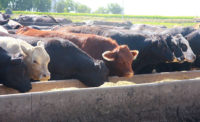 For prepared, frozen muscle foods, the most important quality attributes to the consumer are flavor and texture. This also applies to dumplings (“Jiaozi” in Chinese phonics) — a traditional Chinese delicacy consisting of a wheat-flour dough wrapper and a meat-based filler. Dumplings are widely popular in Asian countries and are served in Asian cuisines worldwide. Pan-fried dumplings in the U.S. are often called potstickers.
For prepared, frozen muscle foods, the most important quality attributes to the consumer are flavor and texture. This also applies to dumplings (“Jiaozi” in Chinese phonics) — a traditional Chinese delicacy consisting of a wheat-flour dough wrapper and a meat-based filler. Dumplings are widely popular in Asian countries and are served in Asian cuisines worldwide. Pan-fried dumplings in the U.S. are often called potstickers.
Today, supermarkets in the U.S. sell Chinese dumplings in the frozen-food section. Commercial dumplings are usually frozen to aid in distribution and quality preservation. However, gradual losses in quality occur during frozen storage, especially when the freezing temperature fluctuates. Depending on the specific package and storage condition, deteriorations in the filler’s flavor and texture (rancidity, hardness and dryness) can be a significant problem, resulting from lipid and protein oxidation and ice crystal-induced physical damage to proteins.
In a recently published studyi, we looked at the impact of frozen storage temperature on quality changes in dumpling fillers. Fillers were prepared by mixing fresh ground pork with appropriate amounts of soybean oil, water, salt, soy sauce, green onion, ginger and spice powder in a Kitchen-Aid mixer until a sticky paste was formed. Filler fat content was adjusted to 10%, 20% and 30% with pork backfat prior to mixing. Dumplings were individually hand-wrapped, with approximately 10 grams of the filler inside the wheat dough wrapper.
The dumplings were placed in styrene foam trays, overwrapped with polyethylene film, and stored for 0, 30, 60, 90 and 180 days at minus-7 °C (retail temperature), minus-18 °C (typical frozen storage temperature), and at an oscillation between those two temperatures (altered every three days; simulating a transportation situation). After storage, raw fillers were evaluated for volatiles, oxidation products and textural properties (instrumental); cooked fillers were evaluated by a taste panel.
Dumplings stored at minus-7 °C for 90 days showed significantly higher levels of lipid oxidation (malonaldehyde, peroxide) and protein oxidation (carbonyls) than those stored at minus-18 °C and the fluctuating minus-7 °C/minus-18 °C. Due to oxidation, the percentage of unsaturated fatty acids decreased with storage time. The volatile compounds with pleasant aromas decreased with time, while the compounds with pungent odors (for example, hexanal and benzeneacetaldehyde produced from oxidized lipids) increased.
Dumplings stored at higher frozen temperatures or for long periods of time received significantly lower acceptability scores. Overall, rancid odors were directly proportional to the degree of lipid oxidation and lower acceptability.
The results suggest that oxidation is a primary cause for flavor deterioration in pork dumpling fillers during frozen storage. On the other hand, dumplings stored at minus-18 °C were significantly juicier and had a better filler texture (greater firmness, smaller pores and fewer cracks) than those stored at minus-7 °C, and the samples subjected to temperature fluctuations had the worst textural properties.
Comparison of filler formulations with different fat contents (10, 20, and 30%) confirmed the expected results: the higher the fat content, the more susceptible the filler became to oxidation, and hence, the less likely acceptable by consumers. Interactions between proteins and aldehydes during frozen storage destabilized the protein structure and promoted protein aggregation and filler hardness.
Several recommendations can be drawn based on the study.
First, it is imperative to use a low temperature and minimize temperature fluctuations during storage and transportation of frozen dumplings; if at all possible, the freezing temperature should be kept close to or lower than minus-18 °C.
Second, despite its contribution to desirable flavors, the content of fat in the filler should not exceed 20%.
Third, the amount of spices and herbs added as flavor ingredients (generally less than 1%) is not sufficient to control oxidation and quality deterioration. Less used but more potent natural antioxidants, such as polyphenol-rich spice extracts, should be considered for improving dumplings’ shelf stability.
i. Huang, L., Xiong, Y.L., Kong, B., Huang, X., and Li, J. 2013. Influence of storage temperature and duration on lipid and protein oxidation and flavour changes in frozen pork dumpling filler. Meat Science 95:295-301.
Also: Kong, B., Huang, L., Xiong, Y.L., Zhao, J., and Liu, Q. 2013. Influence of fat content and storage duration on oxidation an physicochemical changes in frozen pork dumpling filler. Proceedings of 59th International Congress of Meat Science and Technology, Izmir, Turkey, August 18-23, 2013.




Report Abusive Comment